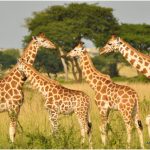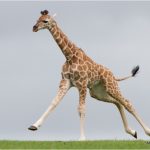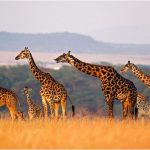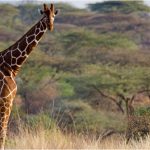Giraffes are said to be tallest living terrestrial animals. Also, they are the largest animals that can gain nutrients from plant based diet, also known as ruminant. A giraffe can be distinguished by its extremely long legs and neck. They have horns like ossicones. The conservation status as of 2016 is vulnerable.
Giraffe Interesting Facts For Kids & Information :
- They are the tallest mammals on earth. Their legs alone can be taller than an average human being, that is, about 6 feet.
- There are four species of giraffe. They are Northern Giraffe, Southern Giraffe, Masai Giraffe and Reticulated Giraffe.
- A giraffe’s neck is short to reach the ground. To drink water, a giraffe has to spread his or legs or kneel down.
- A giraffe can get the required amount of water from the plants he eats. So, a giraffe needs to drink water only sometimes.
- They can run very fast, almost 35 miles an hour.
- Giraffes needs very less sleep. They usually have a nap for about 5 to 30 minutes every 24 hours.
Diet
- As Giraffes are herbivorous, they only eat plants. They use their long necks to reach the branches and shoots of the trees. They usually feed on the acacia leaves.
- A giraffe is a ruminant that is, after chewing the food, the food goes to a specialized stomach before being digested. Here the half-digested cud again passes through the neck to the mouth to chew again. This process to stimulate digestion is known as rumination.
- Giraffes eat about 30 kg of food a day but may sometimes eat as little as 15 kg a day. Also, their diet also depends on their size and the availability of food.
Habitat
Giraffes usually live in the savannas and where there are tall grasses and open woodlands. Their height enable them to eat leaves form tall tress during famine and draught.
Also read:
Behavior
Giraffes usually prefer groups, where the groups are sex segregated. That is, a group may consist of all females with their young ones. But sometimes, the groups may have both male and female members. Giraffes have some home ranges but are not at all territorial.
Giraffe Lifecycle
- A female giraffe give birth to a young one also known as calf after being 15 months pregnant.
- The calf stays near its mother and depends on her for protection and food and drinks its mother milk for about 9 to 10 months.
- When a calf is born it weighs about 150 pounds and stands about 6 feet tall.
- The transformation of a calf to a young adult is very fast and grows about 1 inch every week.
- A giraffe matures at about 3 to 5 years of age.
- They start mating usually from the age of seven.
Predators
Despite being the tallest animals they may sometimes fall prey, especially the young ones, to predators like lions and hyenas. Giraffes usually have good instants and can protect themselves with their long legs by kicking their predators. But the predators target week, old and the young giraffes that are not capable of protecting themselves.
Giraffe Breeding
- Young male giraffes are ready to mate at the age of 7, and females giraffes are ready to mate at the age of 4.
- Reproduction in giraffes is said to polygamous. Male giraffes can find out whether a female is fertile or not by tasting her urine to detect estrous. After finding a mate, the male giraffe tries to keep other males away from his mate. Only the dominant males get to mate with the females.
- The gestation period in giraffes lasts for about 400-460 days.
Giraffe Appearance
- A fully grown male giraffe can stand upto 18.7 feet tall. The average weight of a male giraffe is 1192 kg and the average weight of a female giraffe is 828 kg.
- They have large bulging eyes that give them good vision form its height. Their tongue is long and reaches about 20-21 inches. The giraffes tongue is adapted to grasp foliage and for grooming and cleaning its nose.
- Their skin is thick and acts as camouflage especially for the young ones.
- Both the male and female giraffes have horn like structure known as ossicones.
- The neck of the giraffe is extremely long and may be upto 7.9 feet. Their neck is their main weapon during combat with other males. This is known as necking. Necking is used to establish dominance.
Images, Pics, Images, Pictures of Giraffe :
Life Span
Adults Giraffes have high survival probability because of their height and built. They can live upto 25 years in the wild. But calves are very vulnerable to predators and not many calves make to adulthood.
Health Issues
Giraffes are susceptible to parasites especially ticks that reside on their genital areas where the skin is thinner as compared to other areas. Also, some other parasites may also reside on them making them prone to numerous diseases. Some giraffes are also prone to various skin diseases.
Giraffe Characteristics
- Giraffes have unique pattern on their body and no two giraffes share same pattern.
- As a giraffe is tall, the heart of a giraffe has evolved to generate blood pressure that is double than the blood pressure generated for normal mammal, so that the blood flow to the brain is maintained.
- The giraffe uses its long tongue to clean its face.
- A giraffes legs are extremely strong, and his or her kick can severely injure the predator or may even kill it.

















